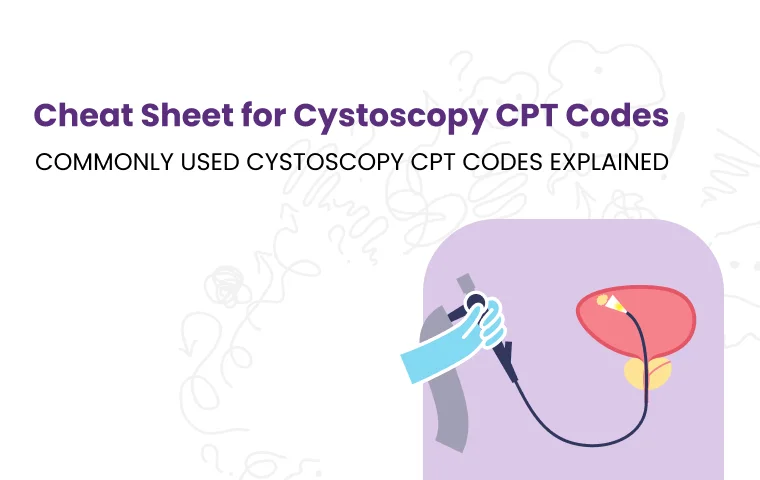Cystoscopy is a procedure you perform often—but when it comes to selecting the right CPT codes, even experienced providers can use a quick reference. From diagnostic exams to therapeutic interventions, accurate coding ensures that your hard work is reflected in clean claims and timely reimbursements.
This guide is designed with your workflow in mind. No fluff, no overcomplication—just the essential codes you need for common cystoscopy scenarios, all in one place. Let’s jump in.
Key Cysctoscopy CPT Codes
Regarding cystoscopy procedures, the CPT code 52000 is often the starting point. This category serves as the foundation for many urological procedures, providing the baseline for diagnostic cystoscopy and expanding into more specialized therapeutic interventions. Let’s break it down step by step to ensure you’re coding accurately and efficiently.
Cystourethroscopy Procedures
1. CPT® 52000: Diagnostic Cystourethroscopy
-
Category: Diagnostic Procedure
-
Description: A simple cystourethroscopy performed to examine the bladder and urethra.
-
Typical Indications:
-
Evaluation of hematuria.
-
Recurrent urinary tract infections.
-
Suspected bladder abnormalities (e.g., stones, lesions).
-
-
Documentation Essentials:
-
Indication for the procedure.
-
Findings during the examination (e.g., "bladder mucosa appeared normal").
-
Confirmation of no therapeutic interventions performed.
-
2. CPT® 52001: Cystourethroscopy with Irrigation and Clot Evacuation
-
Category: Therapeutic Procedure
-
Description: A cystourethroscopy performed to clear clots and ensure bladder patency using irrigation.
-
Typical Indications:
-
Post-operative blood clots obstructing the bladder.
-
Retention of clots due to trauma or bleeding disorders.
-
-
Documentation Essentials:
-
Reason for clot evacuation.
-
Method used (e.g., "continuous saline irrigation via cystoscope").
-
Outcome of the procedure (e.g., "complete clot clearance achieved").
-
3. CPT® 52005: Cystourethroscopy with Ureteral Catheterization
-
Category: Diagnostic or Therapeutic Procedure
-
Description: A cystourethroscopy that includes the placement of a catheter into the ureter(s) for diagnostic evaluation or therapeutic purposes.
-
Typical Indications:
-
Ureteral obstruction or hydronephrosis.
-
Collection of urine samples directly from the kidney for testing.
-
Dye studies for ureteral imaging.
-
-
Documentation Essentials:
-
Reason for catheterization (e.g., "evaluation of left-sided hydronephrosis").
-
Details on catheter placement (e.g., "catheter placed bilaterally").
-
Findings or imaging results.
-
CPT® Code for Cystoscopy with Urethral Dilation
-
CPT® Code 52281:
-
Description: Cystourethroscopy with dilation of the urethra.
-
Purpose:
-
Treatment of urethral strictures.
-
Relief of obstruction in the urethral canal.
-
Evaluation of the urethral lumen and bladder for associated abnormalities.
-
-
Typical Indications:
-
Urethral stricture disease.
-
Post-surgical urethral narrowing.
-
Obstruction causing voiding difficulties
-
-
Cystourethroscopy with Insertion of Indwelling Ureteral Stent (CPT Code 52332)
-
Description: Cystourethroscopy, with insertion of an indwelling ureteral stent (e.g., Gibbons or double-J type).
-
Purpose:
-
Maintain ureteral patency.
-
Relieve ureteral obstructions caused by stones, strictures, or tumors.
-
Post-operative drainage of the upper urinary tract.
-
Facilitate healing after ureteral surgeries.
-
Cystoscopy with Bulkamid Injection (CPT® 51715)
Description: Endoscopic injection of implant material (e.g., Bulkamid) into the submucosa of the urethra and/or bladder neck.
Indications for the Procedure
-
Stress Urinary Incontinence (SUI):
-
Leakage caused by coughing, sneezing, or physical activity.
-
-
Intrinsic Sphincter Deficiency (ISD):
-
Weakness in the urethral sphincter mechanism.
-
-
Post-Surgical Incontinence:
-
Following procedures like prostatectomy or pelvic surgery.
-
Cystoscopy with Stent Removal (CPT® Code 52310 or 52315)
Description: Cystourethroscopy with removal of an indwelling ureteral stent, uncomplicated.
Purpose: Used for straightforward stent removal without additional interventions.
Typical Indications:
-
Removal of a stent placed after a stone removal or other urological procedure.
-
Stents that are no longer needed for urinary drainage.
Documentation Essentials:
-
Indicate that the stent removal was straightforward, requiring no additional manipulation.
Cystoscopy with Bladder Biopsy (CPT® Code 52204)
-
Description: Cystourethroscopy, with biopsy(s) of the bladder.
-
Purpose:
-
To diagnose suspected bladder cancer or other abnormal bladder conditions.
-
To investigate findings such as hematuria, bladder lesions, or inflammatory processes.
-
-
Typical Indications:
-
Bladder tumor or polyp visualized during imaging or prior cystoscopy.
-
Persistent hematuria or abnormal cytology results.
-
Evaluation of chronic bladder inflammation or suspected interstitial cystitis.
-
Cystoscopy with Bladder Biopsy and Fulguration (CPT® Code 52224 or 52214)
Applicable CPT® Codes
-
CPT® 52224
-
Description: Cystourethroscopy with fulguration (including cryosurgery or laser surgery) and/or resection of a small bladder tumor (0.5 cm or less).
-
Purpose: For small bladder tumors where biopsy and therapeutic treatment (fulguration) are performed in the same session.
-
-
CPT® 52214
-
Description: Cystourethroscopy with fulguration of a lesion (excluding tumors or malignancies).
-
Purpose: For non-tumor conditions requiring fulguration and biopsy (e.g., bleeding or inflammatory lesions).
-
Indications for the Procedure
-
Suspected or confirmed bladder tumors, polyps, or lesions.
-
Hematuria with visible bladder abnormalities.
-
Urothelial carcinoma or pre-malignant conditions.
-
Bleeding or vascular abnormalities within the bladder wall requiring fulguration.
Cystoscopy with Suprapubic Tube Placement (CPT® Code 51102)
-
Description: Aspiration of the bladder; with insertion of suprapubic catheter, cystoscopic.
-
Purpose: To provide urinary drainage in cases of obstruction, trauma, or other conditions where urethral catheterization is not possible or practical.
Indications for the Procedure
-
Urethral trauma or obstruction.
-
Failed attempts at urethral catheterization.
-
Long-term management of neurogenic bladder.
-
Post-surgical urinary retention requiring bladder drainage.
Cystoscopy with Botox Injection (CPT® Code 52287)
CPT® Code 52287
-
Description: Cystourethroscopy, with injection(s) for chemodenervation of the bladder.
-
Purpose: To manage bladder dysfunction by temporarily reducing detrusor muscle overactivity.
Indications for the Procedure
-
Overactive Bladder (OAB):
-
When anticholinergic medications or other conservative treatments fail.
-
-
Neurogenic Detrusor Overactivity:
-
Common in conditions such as spinal cord injuries or multiple sclerosis.
-
-
Urinary Incontinence:
-
Resulting from detrusor muscle hyperactivity.
-
When Blue Light Cystoscopy is Used
Blue Light Cystoscopy is often employed for detecting and evaluating bladder cancer. It involves the use of a photosensitizing agent (e.g., hexaminolevulinate or Cysview) and blue light to enhance the visualization of cancerous lesions in the bladder.
Injection of the Photosensitizing Agent:
-
If hexaminolevulinate (Cysview) is used, report it with the HCPCS code: A9589 (Hexaminolevulinate hydrochloride, 100 mg).
Guidance for Use with Biopsies or Tumor Resection:
-
If biopsies or resection of bladder tumors are performed during the procedure, additional codes such as CPT® 52234–52240 may be used, depending on the size and complexity of the tumor(s).
Blue Light Cystoscopy Alone:
-
If the cystoscopy is performed solely for diagnostic purposes without biopsy or other interventions, use CPT® 52000 (Cystourethroscopy, diagnostic).
Cystoscopy with Hydrodistention (CPT® Code 52260 or 52265)
-
CPT® 52260
-
Description: Cystourethroscopy with dilation of the bladder for interstitial cystitis or other conditions.
-
Purpose: Used for diagnostic purposes or to provide temporary symptomatic relief by stretching the bladder walls.
-
-
CPT® 52265
-
Description: Cystourethroscopy with dilation of the bladder and installation of therapeutic agent(s) (e.g., DMSO, heparin, or other medications).
-
Purpose: Used for diagnostic hydrodistention with simultaneous therapeutic instillation of medication into the bladder.
-
Cystoscopy with Retrograde Pyelogram (CPT® Code 52005)
-
Description: Cystourethroscopy with catheterization of the ureter(s) and/or renal pelvis for a retrograde pyelogram.
-
Purpose:
-
To evaluate ureteral or renal abnormalities, such as obstructions, strictures, stones, or tumors.
-
To obtain detailed imaging of the upper urinary tract.
-
Cystoscopy with Urethral Dilation and Foley Catheter Placement (CPT® Code 52281)
-
Description: Cystourethroscopy with dilation of the urethra and insertion of a Foley catheter.
-
Purpose:
-
To treat urethral strictures or narrowing caused by trauma, infection, or scarring.
-
To restore normal urinary flow and manage urinary retention.
-
Final Words
Accurate coding is the foundation of successful urology billing. From cystoscopy procedures to advanced interventions, ensuring precision in CPT® codes is essential. Trust HMS USA LLC to streamline your urology billing services, maximize reimbursements, and minimize administrative burdens.
ABOUT AUTHOR

Pedro Collins
As a blog writer with years of experience in the healthcare industry, I have got what it takes to write well-researched content that adds value for the audience. I am a curious individual by nature, driven by passion and I translate that into my writings. I aspire to be among the leading content writers in the world.
